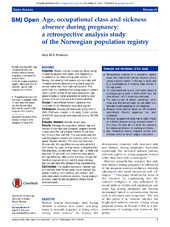| dc.contributor.author | Ariansen, Anja Maria Steinsland | eng |
| dc.date.accessioned | 2014-12-08T10:53:24Z | en_US |
| dc.date.accessioned | 2014-12-09T08:36:08Z | en_US |
| dc.date.accessioned | 2014-12-10T11:50:41Z | |
| dc.date.available | 2014-12-10T11:50:41Z | |
| dc.date.issued | 2014-05-02 | eng |
| dc.identifier.issn | 2044-6055 | |
| dc.identifier.uri | https://hdl.handle.net/1956/8887 | |
| dc.description.abstract | Objective Western women increasingly delay having children to advance their career, and pregnancy is considered to be riskier among older women. In Norway, this development surprisingly coincides with increased sickness absence among young pregnant women, rather than their older counterparts. This paper tests the hypothesis that young pregnant women have a higher number of sick days because this age group includes a higher proportion of working class women, who are more prone to sickness absence. Design A zero-inflated Poisson regression was conducted on the Norwegian population registry. Participants All pregnant employees giving birth in 2004–2008 were included in the study. A total number of 216 541 pregnancies were observed among 180 483 women. Outcome measure Number of sick days. Results Although the association between age and number of sick days was U-shaped, pregnant women in their early 20s had a higher number of sick days than those in their mid-40s. This was particularly the case for pregnant women with previous births. In this group, 20-year-olds had 12.6 more sick days than 45-year-olds; this age difference was reduced to 6.3 after control for class. Among women undergoing their first pregnancy, 20-year-olds initially had 1.2 more sick days than 45-year-olds, but control for class altered this age difference. After control for class, 45-year-old first-time pregnant women had 2.9 more sick days than 20-year-olds with corresponding characteristics. Conclusions The negative association between age and sickness absence was partly due to younger age groups including more working class women, who were more prone to sickness absence. Young pregnant women's needs for job adjustments should not be underestimated. | en_US |
| dc.language.iso | eng | eng |
| dc.publisher | BMJ | eng |
| dc.relation.ispartof | <a href="http://hdl.handle.net/1956/15705" target="_blank">Women’s sickness absence in contemporary Norway. The impacts of class, motherhood, and pregnancy</a> | |
| dc.rights | Attribution-NonCommercial CC BY-NC | eng |
| dc.rights.uri | http://creativecommons.org/licenses/by-nc/3.0/ | eng |
| dc.title | Age, occupational class and sickness absence during pregnancy: a retrospective analysis study of the Norwegian population registry | eng |
| dc.type | Peer reviewed | en_US |
| dc.type | Journal article | en_US |
| dc.date.updated | 2014-12-08T10:53:24Z | en_US |
| dc.description.version | publishedVersion | |
| dc.rights.holder | Copyright 2014 Ariansen | en_US |
| dc.source.articlenumber | e004381 | |
| dc.identifier.doi | https://doi.org/10.1136/bmjopen-2013-004381 | |
| dc.identifier.cristin | 1140991 | |
| dc.source.journal | BMJ Open | |
| dc.source.40 | 4 | |
| dc.source.14 | 5 | |
| dc.subject.nsi | VDP::Social sciences: 200::Sociology: 220 | eng |
| dc.subject.nsi | VDP::Samfunnsvitenskap: 200::Sosiologi: 220 | nob |

